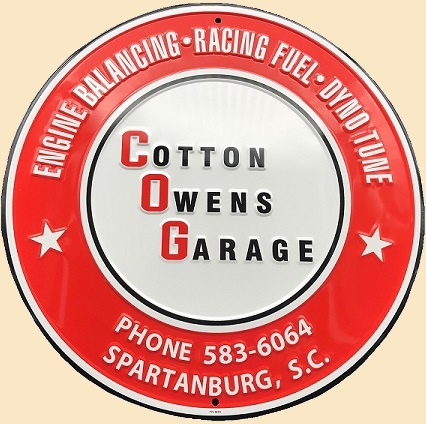
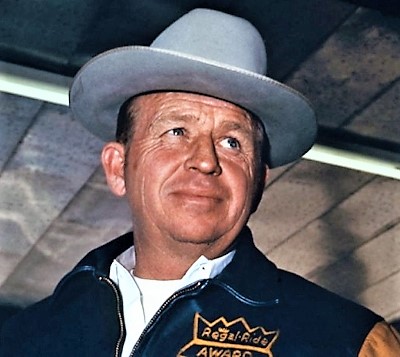
COTTON OWENS - 05-21-1924 - 06-07-2012 -
his career started in 1950 as an owner /driver in the NASCAR Cup Series. Owens would enter a few races over the next several seasons without a win. Cotton's first win came on February 17, 1957 at the series' premiere event: The Daytona Beach and Road Course. Owens once drove a 1957 Pontiac to victory; the win was also Pontiac's first NASCAR win. In 1959, Owens finished second to Lee Petty in the race for the NASCAR championship, although he did not enter many Cup races, as he preferred the Modified circuit which at this time had bigger crowds, faster cars and higher purses to be won. Though Cotton only won one race that season (at Richmond International Raceway), Cotton was making a name for himself as a racer. He attempted 37 races that season, with 22 Top 10s and 13 Top 5s. In 1961 he had his most productive season with 11 Top 5s and four wins in only 17 starts. He had a win at his hometown of Spartanburg, SC. (Piedmont Interstate Fairgrounds). As Cotton
transitioned to NASCAR's Grand "Stock Car" division, he would cement his place among the sport's elite drivers building and driving Pontiacs wearing his now signature red and white color scheme and infamous #6. What made Owens great was not only his driving ability, but his mechanical aptitude and car preparation that made him a force to be reckoned with wherever he raced, on dirt or on pavement. Cotton would capture 5 Grand National victories through 1960-62 as a driver, and would also put several notable drivers behind the wheel, including Bobby Johns, Ralph Earnhardt, Marvin Panch, Fireball Roberts, Junior Johnson, and fellow Spartanburger David Pearson, who was making a name for himself as an up-and-coming
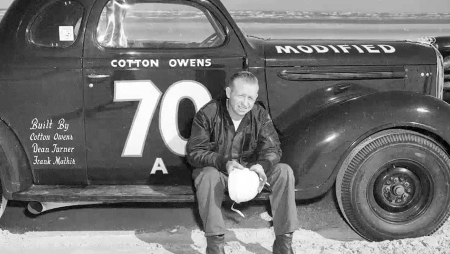

driver. Cotton Owens Garage would earn six victories during these years, as well as 31 Top Fives and 38 Top Ten finishes, and 5 Pole Positions. Owens would put his Pontiac on Pole for the 1960 Daytona 500 and also shatter the qualifying record at Darlington with a 126.146 mph average speed. In 1962 he hired legendary driver and car owner Junior Johnson. He also started his relationship with fellow Spartanburg resident David Pearson. He came out of retirement in 1964 to prove that he could beat Pearson. He beat Pearson in his final career win (at Richmond). Two races later he finished second in his final career race (to Ned Jarrett). In 1963, Cotton would sign with Dodge as a factory team, fielding a stable of race cars. Owens built a new 20,000 sf garage behind his home, which would be the epicenter of racing in Spartanburg, South Carolina. Although the team would not win a race in their first season with Dodge, they did earn 17 Top 5 and 34 Top 10
finishes, as well as 2 pole positions. Chrysler released the hemispherical combustion chamber engine in 1964 and took stock car racing to a new level. 1964 would be the breakout season for the Cotton Owens team, with Owens tapping the Hemi's potential and hotshoe David Pearson capturing 8 wins on the Grand National circuit, 29 Top Fives, and 42 Top Ten finishes. That success would soon be interrupted, however, as the Hemi powerplant proved to be so dominant that NASCAR banned the Hemi from competition in mid-1965, and Chrysler in turn boycotted NASCAR racing. They ran a Hemi in the back of a Dodge Dart drag racing car. They ran nitro and alcohol in the Experimental class. They returned to NASCAR in 1966, and they won the Grand National Championship. They parted
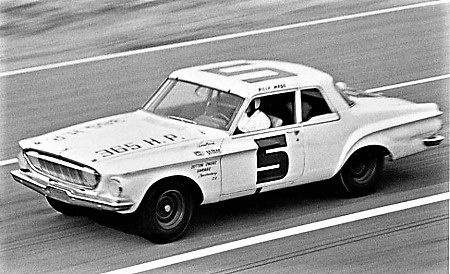
Billy Wade 1962

David Pearson 1966
ways early in the 1967 season. During their six seasons together Owens and Pearson combined for 27 wins in 170 races With dwindling factory and fan support following NASCAR's ban of the Hemi from competition in 1965, NASCAR relented in 1966 and again changed the rules to allow the Hemi back on the track, with concessions made for Ford and General Motors to help even the competition. Chrysler was intent on picking up where they left off, and indeed they did, putting full factory support and engineering resources at the disposal of the factory racing teams, with Cotton Owens Garage and the Pettys leading the charge. 1966 would be the breakout year for the
Cotton Owens Dodge team, now in their fourth year and hitting full stride on the NASCAR circuit. With David Pearson as his primary driver and Cotton now out of the driver's seat and working full-time under the hood, they would go on to claim 15 victories on the Grand National tour and capture the NASCAR Championship. With Owens' mechanical wizardry and the Hemi engine powering the COG Dodges they were nearly unbeatable that year, and their successful partnership made hometown Spartanburg very proud indeed. Other notable drivers would climb behind the wheel for Owens in 1966-67, including Buddy Baker, Bobby Isaac, Bobby Allison, Darel Dieringer, Ray Hendrick, Sam McQuagg, and open-wheel hotshoe Mario Andretti who would come South for the big race at Daytona and looked to Cotton to put him in a ride capable of
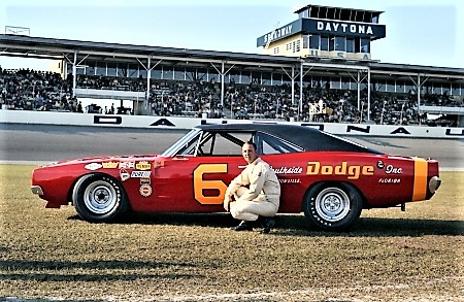
Chargin' Charlie Glotzbach 1969
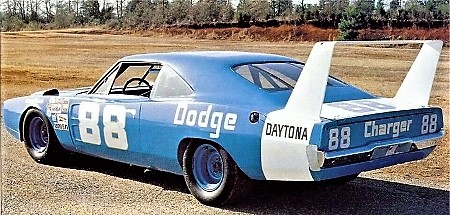
Buddy Baker's 200 mph Record run Charger
winning. And winning was becoming commonplace at Cotton Owens Garage during its heyday of the mid 1960s. The end of the 1960s saw the Cotton Owens Garage campaigning Dodges in a variety of form factors designed specifically for maximum performance at different tracks, including the Charger 500 and Charger Daytona that turned NASCAR racing on its head and forever changed the way aerodynamics would affect motor sports competition. Drivers of this era include "leadfoot" Buddy Baker, Chargin' Charlie Glotzbach, Sam Posey, and open-wheel star Al Unser. On March 24 1970, at Talladega
International Speedway; Buddy Baker would wheel a Cotton Owen owned Dodge Charger Daytona to an official closed course record of average lap of 200.447 mph; becoming the first man to ever break the 200 mph barrier. Baker's lone win in a Cotton Owens Dodge would come at the Darlington Southern 500 in 1970, a race Cotton wanted to win so badly but which had eluded him as a driver and owner for more than 20 years. Buddy's all-out style would serve him well as he would pilot the Chrysler Engineering blue Daytona #88 to a new closed-course record of better than 200 mph at Talladega on March 24th., 1970. The dawn of the 70s would see the Cotton Owens Garage switch from Dodge to Plymouth, as Chrysler wanted to resurrect the marque by giving it more of a performance edge. The dominance of the Dodge Daytona and Hemi combination had given no choice to

Buddy Baker's Southern 500 win 1970
Pete Hamilton 1971
NASCAR but to outlaw both the car and the engine, requiring new restrictor plates on the super speedways. For the 1971 season, Cotton Owens teamed up with Pete Hamilton, who would pilot his '71 Plymouth Roadrunner to victory lane at the 1971 Daytona 500 qualifier. Hamilton would start a total of 20 races, with 1 Win, 11 Top Fives, and 12 Top Tens. Other drivers included Charlie Glotzbach, Peter Gregg, and yet another Spartanburg native named Dick Brooks. During this era, the same car would often be re-bodied as either a Plymouth Roadrunner or a Dodge Charger, utilizing the same chassis and drive train but updated to keep up with NASCAR rule changes or factory dictates. Another notable fellow to climb behind
the wheel of a Cotton Owens Garage race car during this time was none other than legendary country-western musician Marty Robbins. Marty loved NASCAR racing and as he had the funds to do so, he raced occasionally. His cars were built and maintained by Cotton Owens up until his death in 1982. Marty always tried to race at the big race tracks (Talladega and Daytona) every year, and then a smattering of the smaller races when time permitted. Buddy Baker would win the 1970 Southern 500 and it would be Owens last full length race win. His final win came when Pete Hamilton won a qualifying race for the Daytona 500 in 1971. Owens final race as a car owner
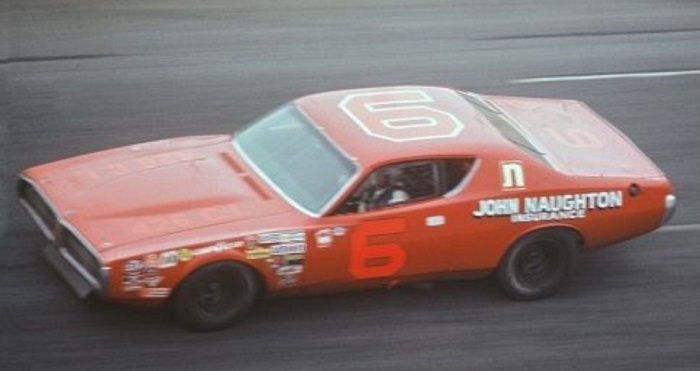
Dick Brooks 1973
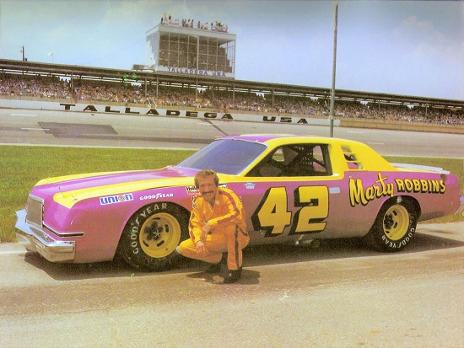
Marty Robbins 1979 Dodge Magnum at Talladega
would come at the 1971 World 600. Peter Gregg would wheel the familiar #6 one final time. He would start seventh; but he would crash out on lap 34 and finish 37th. For his career as a driver he would run in 160 races; winning nine times. But as a car owner, Owens shined. He fielded cars from 1950-1973. Just a partial list of the all star drivers that sat behind the wheel of his cars include: David Pearson, Fireball Roberts, Junior Johnson, Bobby Isaac, Buddy Baker, Ralph Earnhardt, Jim Paschal, Charlie Glotzbach and many others. In all, a total of 25 drivers climbed behind the wheel of Owens' cars in 291 races, earning 32 victories and 29 pole positions. In total, as a car owner and as a driver, Owens' career statistics include 41 wins and 38 poles in 487 races; many with David Pearson at the controls. Seven years after being diagnosed with lung cancer, Owens died on June 7, 2012 at the age of 88, just a few weeks after it was announced he would be inducted into the NASCAR Hall of Fame's 2013 class.
All Photos copyright and are property of their respective owners
